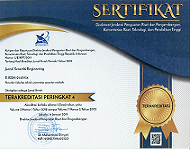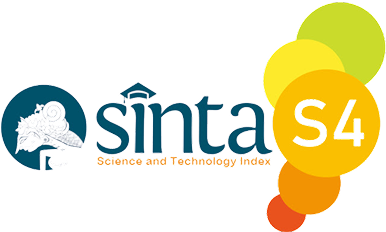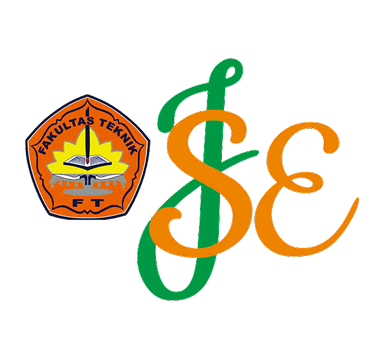Analisis Kinetika Laju Pertumbuhan Lumpur Aktif Artificial menggunakan Karbon Aktif pada Tahap Seeding
Keywords:
wastewater, activated sludge, seeding, artificial activated sludgeAbstract
Textile industry WWTP systems generally use chemical and biological activated sludge. Activated sludge systems tend to require a long retention time and are less effective in degrading color. One technology that can be developed is the improvisation of activated sludge microorganisms with the addition of powdered activated carbon. This research is to develop a combination technology of powdered activated carbon addition in the seeding stage and see its effect on the growth rate of microorganisms during the seeding and acclimatization stages. The initial stage was a seeding process using liquid starter bacteria carried out in 5 reactors with a capacity of 5 L, with the dose of activated carbon addition in reactors 1, 2, 3, 4 and 5 namely 0 mg/l, 100 mg/l, 400 mg/l, 800 mg/l and 1000 mg/l and a blank reactor with only activated carbon without the addition of starter bacteria. Parameters observed during the study were DO, pH, MLSS and COD values. The seeding process is carried out for 28 days until the MLSS reaches 2000 mg/l, followed by an acclimatization stage which is carried out for 30 days with a COD value set at 1000 mg/l using an artificial substrate. At the seeding stage, the optimal reactor was R5, which was based on the increase in MLSS over time and the kinetics of growth rate as a µmax value of 0.2179 days⁻¹ and acclimatization stages 1 and 2 with µmax values of 0.0853 days⁻¹ and 0.0959 days-1, respectively.
References
[1] A. Asadi dan M. Rostami. (2021). An Assessment on the performance of activated carbon augmented by activated sludge for removing Methylene blue. Journal of Desalination and Water Treatment.
[2] Arimbi, Ayu. (2017). Efektivitas Tanaman Melati Air (Echinodorus Palaefolius) Dalam Menurunkan Kadar BOD (Biologycal Oxygen Demand) dan COD (Chemical Oxygen Demand) serta TSS (Total Suspended Solid) pada Limbah Cair Tempat Pemotongan Ayam di Kecamatan Delitua Kabupaten Deli Serdang. Skripsi. Universitas Sumatera Utara.
[3] Azary Ruth, Perpetua, & Slamet D. I. A. (2019). Pengolahan Limbah Cair Rumah Makan Menggunakan Kombinasi Surfaktan dan Aktivator dengan Sistem Kerja Lumpur Aktif. Tugas Akhir. Institut Teknologi Sepuluh November. Surabaya.
[4] Badan Pusat Statistik. (2019). Industri manufaktur pada kuartal III-2019 tumbuh 4,35%. Retrieved from kontan.co.id.
[5] Bailey, James E. & David F.Ollis. 1986. Biochemical Engineering Fundamentals, edisi 2, McGraw-Hill Book Co. Singapore.
[6] Bornare, J., Kalyanraman, V., Sonde, R. R., Kalyanraman, V., & Sonde, R. R. (2014). Application of anaerobic membrane bioreactor (AnMBR) for low-strength wastewater treatment and energy generation. Industrial Wastewater Treatment, Recycling and Reuse, 399-434.
[7] C. G. Grieves and M. K. Stenstrom, Amoco Oil Co., Naperville, Ill., and J. D. Walk, and J. F. Grutsch. (1977). Powdered carbon improves activated sludge treatment. Journal of Hydrocarbon Processing. Enviromental Management.
[8] Dayanti, R., & Herlina, E. (2018). Proses Seeding dan Aklimatisasi pada Pengolahan Air Limbah. ITN Malang.
[9] Fitria, K. A., & Sutrisno, J. (2023). Penurunan Chemical Oxygen Demand (COD) dan fosfat (PO4-P) limbah laundry menggunakan EM4 dan mikroalga Spirulina sp. Jurnal Sains & Teknologi Lingkungan, 15(1), 31-44.
[10] Haris, A., Nurhilal, O., dan Suryaningsih, S., 2019. Pengaruh Konsentrasi Aktivator terhadap Daya Serap Iodin Arang Aktif dari Limbah Daun Ki Sabun (Filicium decipiens) dan Daun Mahoni (Swietenia mahagoni). Jurnal Material dan Energi Indonesia. Universitas Padjadjaran. 9(1): 1-7.
[11] Herald, Denny. (2010). Pengaruh Rasio Waktu Reaksi Terhadap Waktu Stabilisasi Pada Penyisihan Senyawa Organik Dari Air Buangan Pabrik Minyak Kepala Sawit Dengan Seuqncing Batch Reactor. Jurusan Teknik Lingkungan. Fakultas Universitas Andalas. Sumatera Barat.
[12] Kumalasari, F. G. (2016). Pengaruh Penambahan Kosubstrat Asam Asetat Terhadap Konsentrasi COD Dan MLSS Limbah Cair Industri Batik.
[13] Mai, H.N.P. (2006). Integrated Treatment of Tapioca Processing Industrial Wastewater. Thesis. Wageningen University: Ph.D.
[14] Metcalf, and Eddy. (2003). Wastewater Engineering Treatment and Reuse. 4th Edition. McGraw-Hill. New York.
[15] Mukhtar, G., Iwan, R., Mina, N., & Tintin, S. R. (2017). Pemanfaatan Nutrisi Terfermentasi untuk Penurunan Kadar COD/BOD Air Limbah Industri. Journal Industrial Services, 3(1b).
[16] Mulyani, H., Sasongko, S. B., & Soetrisnanto, D. (2012). Pengaruh preklorinasi terhadap proses start up pengolahan limbah cair tapioka sistem anaerobic baffled reactor. Momentum, 8(1), 21-27.
[17] Mustikawati, S. R., Simpen, I. N., & Ratnayani, O. (2018). Adsorpsi Zat Warna Tekstil Remazol Brilliant Blue Oleh Limbah Canang Daun Kelapa. Jurnal Kimia. 195.
[18] Nilesh S, Anil G. (2018). Isolation, characterization and identification of extracellular enzyme producer Bacillus licheniformis from municipal wastewater and evaluation of their biodegradability. Biotechnology Research and Innovation. 2: 37-44. https://doi.org/10.1016/j.biori.2018.03.001.
[19] Notonugroho, O. J., Amelia, F., Arif, C., & Kurniawan, A. (2022). Model Parameter Kinetika Biologis Proses Lumpur Aktif Air Limbah Kertas Berdasarkan Variasi Waktu Detensi Pada Kondisi Tidak Tunak. Vol, 20, 829-840.
[20] Prabarini, N., dan Okayadnya, D., 2014. Penyisihan Logam Besi (Fe) pada Air Sumur dengan Karbon Aktif dari Tempurung Kemiri. Envirotek: Jurnal Ilmiah Teknik Lingkungan. 5(2): 33–41.
[21] Priyadi, A. R. (2019). Penurunan Kadar COD Dan Warna Limbah Industri Tekstil Dengan Metode Elektro-Fenton. Envirotek: Jurnal Ilmiah Teknik Lingkungan, 11(2), 14-23.
[22] Qatrunada, S. H., Novembrianto, R., & Ali, M. (2025). Penyisihan Parameter Organik dan Analisis Kualitas Lumpur Limbah Cair Rumah Potong Ayam dengan Moving Bed Biofilm Reactor. Jurnal Serambi Engineering, 10(1).
[23] Rachmawati, V., Nurjayati, R., & Yuniati, M. D. (2022). Penurunan konsentrasi cod limbah batik pada proses seeding dan aklimatisasi menggunakan material preservasi mikroorganisme (mpmo). Jurnal Kesehatan Lingkungan Indonesia, 21(1), 73-82.
[24] Rokhmadhoni, R. A., & Marsono, B. D. (2019). Kulit Kerang Sebagai Media Alternatif Filter Anaerobik Untuk Mengolah Air Limbah Domestik. Jurnal Teknik ITS, 8(1), F46-F50.
[25] Rosidin, H. I. (2018). Unjuk Kerja Tray Bioreactor Dengan Media Penyangga Batu Andesit Dalam Meningkatkan Kualitas Air Olahan Parameter COD Dan TSS Pada IPAL Komunal.
[26] Salimin, Zainus dan Jaka Rachmadetin. (2012). Denitrifikasi Limbah Radioaktif Cair Yang Mengandung Asam Nitrat Dengan Proses Biooksidasi.
[27] Sari, F. R., Annissa, R., & Tuhuloula, A. (2013). Perbandingan limbah dan lumpur aktif terhadap pengaruh sistem aerasi pada pengolahan limbah cpo. Konversi, 2(1), 39-44.
[28] Septiani, W. D., Slamet, A., & Hermana, J. (2014). Pengaruh konsentrasi substrat terhadap laju pertumbuhan alga dan bakteri heterotropik pada sistem HRAR. Jurnal Teknik ITS, 3(2), D98-D103.
[29] Soeparno. (1992). Ilmu Gizi dan Pangan. Jakarta: PT Gramedia Pustaka Utama.
[30] Tambunan, V. N. (2023). Analisis Zat Organik Pada Air Sumur Gali Warga Di Desa Kaliserayu Sientis, Kecamatan Percut Sei Tuan, Kabupaten Deli Serdang. Doctoral dissertation. Universitas Medan Area.
Downloads
Published
Issue
Section
License
Copyright (c) 2025 Angga Mustofa Priyoharjo, Prayatni Soewondo (Author)

This work is licensed under a Creative Commons Attribution 4.0 International License.












